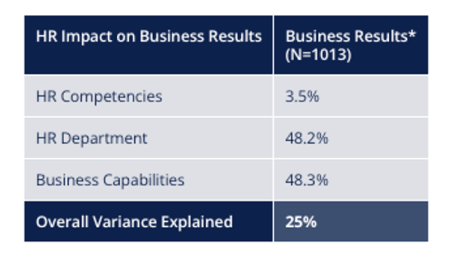Why improving HR can boost business performance
- 6 Min Read
In driving better business performance, business leaders should not ignore the impact of well-designed and delivered HR work that defines and builds critical capabilities
- Author: HRD Connect
- Date published: Nov 15, 2021
- Categories

How much does HR’s work contribute to overall business results? This is a challenging question, given all the variables that impact business performance. So challenging, in fact, that most of the time, business and HR leaders look to qualitative explanations.
Occasionally, however, we have the chance to accurately measure the correlation between HR’s actions and organisational results.
The last round of the HR Competency Study, led by RBL and the University of Michigan conducted earlier this year provide one such opportunity.
Findings from this research demonstrate that of all the variables (business strategy, economic conditions, direct competitors, products, customer preferences, etc.) that influence a given organisation’s results, HR work can explain over 25% of the total variation in business results among more than 1,000 organisations included in the study from around the globe.
We believe this is an important number, as it implies that wherever HR is not a full partner in accelerating results by advancing human capabilities, organisations and their leaders are giving up one-quarter of their potential performance.
They are essentially running a competitive race on a three-legged horse. This not very promising scenario is the best you can expect without effective HR organisations.
Furthermore, the study tells us that although everybody is entitled to an opinion about HR work, there are three concrete paths ways for HR to enhance results:

*This column sums to 100%, representing the percentage of explained variance in the model that can be explained by each variable category.
It doesn’t seem wise for any organisational leader to ignore HR when it doesn’t perform at its full potential. To help your organisation get better results, focus on how well HR defines and builds key business capabilities, has the characteristics of high performing HR functions, and develops the right individual competencies in HR professionals.
Defining business capabilities
HR partners must come together with the rest of the organisation to align and deliver on the few and critical capabilities that provide a competitive advantage. When we work as consultants with many organisations, we always ask their leadership team members to tell us what their organisation needs to be effective in the marketplace.
A correlation we always find is that with higher alignment around what needs to be done the organisation performs better. In order to know which capabilities make a difference in becoming more agile at every level, you need to continuously adapt your organisation and align your culture, leadership, and talent accordingly.
Without the right HR leadership and processes, it’s very difficult to achieve effective agility. Furthermore, HR’s ability to align behaviour and purpose with performance at the individual, team, and organisational level, becomes essential when we need a faster, empowered and diverse organisation that connects to all customers effectively.
Business capabilities, together with the HR department (or how the function organises to deliver and reinforce these capabilities) accounts for almost all of HR’s contribution to business results. HR’s role in helping the business define and build business capabilities is essential.
Detailing the HR department’s effectiveness
The second path through which HR impacts business results: the HR organisation’s effectiveness, especially how HR’s practices and policies build human capability, or help employees to elevate their results and to improve their experience and engagement.
This also has to do with how much HR’s practices reinforce and build those critical business capabilities to create and sustain competitive advantage. For example, if we want an innovative organisation, we can’t continue to punish every mistake.
If we want to move more quickly in taking ideas into prototypes, HR needs to drive organisational changes that reduce complex bureaucracy. HR’s practices need to foster strategy.
HR organisations also add value when it has the right data and analytic capabilities to provide useful information that leads to better and more agile decisions. Trust and reliability in the HR organisation is as important as trust and reliability in finance, and yet we are surprised to see how many organisations make money decisions based on data but fail to do it or even try to do it, in HR decisions.
This second path also contributes significantly to the 25% impact on business results. To get better results, business and HR leaders need to focus on how HR functions can reinforce and build business capabilities through agile, data-based strategic support.
Outlining HR’s competencies
The third and final path is the direct contribution of HR professionals to business results. It accounts for the smallest amount of HR’s contribution to business results, which might be expected since HR professionals normally don’t interact much with creating products and services, or with delivering to customers.
This figure shows us that HR needs to work as a team effectively within the HR organisation and with the rest of the organisation to understand deeply how all processes impact business results.
The results from round eight of the HRCS underline the importance of the competencies required to position HR work in the context of the organisation and shape actions that build business performance.
It identifies the HR professional’s ability to accelerate business through advancing human capabilities, as the main competencies for today’s effective HR professionals.
This starts with the ability to simplify today’s complexity, as HR professionals need to understand what’s going on in their organisation, with their people and with society, in order to find the mindset and cultural leverages that debottleneck required changes.
Then HR needs to know how to mobilise the information and foster collaboration at every level to connect the dots in simple ways that enable everyone to articulate and implement strategy effectively.
What happens with HR “traditional” competencies? They are required tools to do good HR work. However, when you need agile organisations that are evolving their strategy and the way they do things continuously, HR needs to step up so that all organisational processes become an integral part of this evolution.
With any evolution, the faster your HR organisation and your HR professionals develop today’s required capabilities, the bigger the cumulative effect in business results and stakeholder’s confidence and value. Or, to say it the other way around, those who lag in taking advantage of HR’s full potential and capabilities, could very quickly be left behind by customers, investors and even their own employees.
Making gains from research
HR’s full organisational impact is needed in today’s working environment and rapid pace. Up to 25% of your ability to deliver results depends on it, and HRCS round eight findings provide us with a simple framework for each path through which HR impacts organisational results.
So please, ask how well your organisation’s HR delivers as a business partner and accelerator, as an effective organisation, and as a team of competent business professionals. Your business’s future depends significantly on your answers.
Authors: Rodrigo Calderon, Michael Ulrich, Patrick Wright and Erin Wilson Burns.







